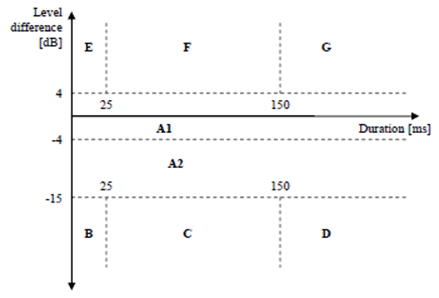Content for TS 26.131 Word version: 18.1.0
0…
5…
5.4…
5.4.3…
5.4.5…
5.4.7…
5.5…
5.8…
5.12…
6…
6.4…
6.4.3…
6.4.5…
6.4.7…
6.5…
6.8…
6.11…
6.12…
7…
7.4…
7.5…
7.8…
7.11…
7.12…
8…
8.4…
8.5…
8.8…
8.11…
8.12…
7.12 Echo control characteristics
7.12.1 Handset
7.12.2 Headset
7.12.3 Handheld hands-free
7.12.4 Desktop hands-free
7.12.5 Electrical interface
7.13 Clock accuracy
7.14 Jitter buffer management behaviour
...
...
7.12 Echo control characteristics p. 89
Echo cancellation is commonly deployed in the UE to fulfil the Acoustic echo control requirements. Echo cancellers are complex devices of which the subjective performance is affected by several attributes. The main attribute is its ability to suppress echo. The process of suppressing the echo may introduce impairments to the near-end speech signal, mainly manifested as distortion or clipping of the near-end signal during simultaneous speech from both the far and near-end ("double-talk").
To characterise the echo control performance, the activity (in % of total time) and averaged level difference (in dB) of the duration of any level difference according to Figure 22 and Table 33 between the clean near-end signal and the send-signal shall be reported for "double-talk" as well as the far-end single talk periods adjacent to the "double-talk".
All percentage values and averaged level differences described in the relevant test of TS 26.132 shall be reported.

| Category | Description |
|---|---|
| A1 | Full-duplex and full transparency |
| A2 | Full-duplex with level loss in Tx |
| B | Very short clipping |
| C | Short clipping resulting in loss of syllables |
| D | Clipping resulting in loss of words |
| E | Very short residual echo |
| F | Echo bursts |
| G | Continuous echo |
7.12.1 Handset p. 90
Requirements are for further study.
7.12.2 Headset p. 90
Requirements are for further study.
7.12.3 Handheld hands-free p. 90
Requirements are for further study.
7.12.4 Desktop hands-free p. 90
Requirements are for further study.
7.12.5 Electrical interface |R17| p. 90
Requirements are for further study.
7.13 Clock accuracy |R14| p. 91
For MTSI-based speech-only with LTE, NR or WLAN access, the clock skew in send direction between the device under test and the reference client should be less than 50 PPM (in absolute value) in error-free conditions.
Compliance shall be checked by the relevant test described in TS 26.132.
7.14 Jitter buffer management behaviour |R14| p. 91
For MTSI-based speech-only with LTE, NR or WLAN access, a jitter buffer is used in receiving to handle the variation in packet receiver timing (see clause 8 of TS 26.114).
If the jitter buffer management (JBM) behaviour is evaluated, the following statistics shall be reported for conditions specified in TS 26.132:
- Delay histogram (on a per sentence basis)
- Quality loss histogram (on a per sentence pair basis)